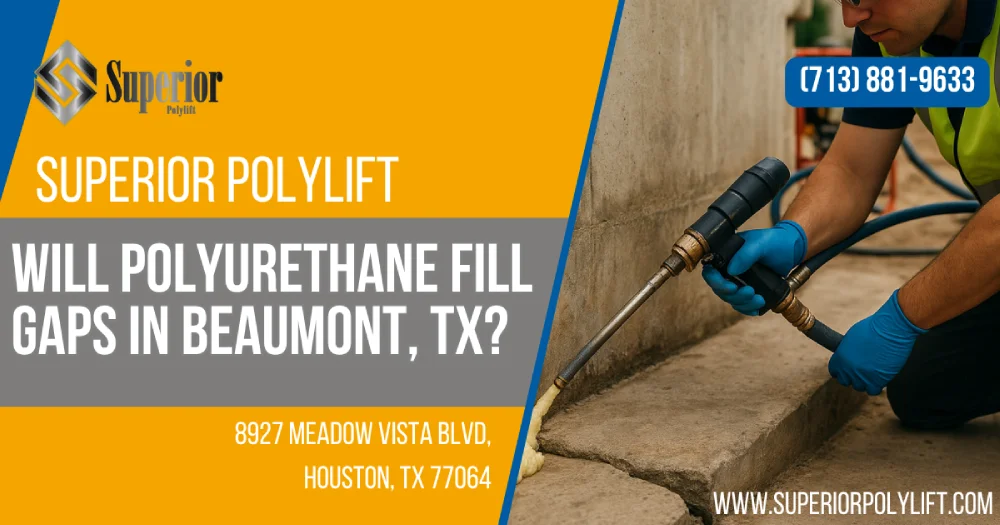
Polyurethane frequently steps in when critical infrastructure in Southeast Texas starts to settle, shift, or crack. Yes, polyurethane can be used to fill gaps in Beaumont, TX. Polyurethane foam is commonly used for filling voids and cracks—especially those beneath a concrete slab or other heavy concrete structures—because the foam expands to fill, cures fast, and supports the surface back to its original level. This modern repair method, also known as polyurethane concrete lifting or polyurethane grouting, is particularly effective in areas with high water tables, as the foam is hydrophobic and long-lasting. When you need a cost-effective, low-downtime repair solution that stands up to humid, flood-prone conditions, polyurethane offers a reliable way to restore support without shutting down operations for days.
Beaumont’s humid subtropical climate, shallow clay soils, and fluctuating groundwater levels create perfect conditions for void formation beneath concrete infrastructure. This section explains how polyurethane adapts to those specific challenges while offering rapid, durable stabilization—far superior to traditional concrete repair methods.
Frequent rainfall and tropical storm surges saturate clays, causing them to swell and later shrink when dry spells return. Over time, those movements carve out gaps beneath pavement and foundations. Polyurethane’s closed-cell structure blocks water migration, preventing the new voids that often plague cementitious grouting in Beaumont.
Summer temperatures routinely climb above 95 °F, yet polyurethane foams are engineered to cure within minutes across a broad thermal range. Even in peak heat, injections expand predictably, allowing contractors to maintain tight lift tolerances without lengthy cool-down delays.
| Property | Polyurethane Foam | Cementitious Grout | Epoxy Resin |
| Unit Weight (pcf) | 2–6 pcf | 120 pcf+ | 60–90 pcf |
| Water Resistance | Excellent (closed-cell) | Moderate | Good |
| Cure Time | 15 min – 1 hr | 1–3 days | 6–24 hrs |
| Added Load to Subgrade | Negligible | Significant | Moderate |
| Traffic Reopen Time | Same day | Multiple days | 1 day |
Every large-scale gap-filling option has pros and cons. Polyurethane consistently stands out for its speed, strength-to-weight ratio, and resilience in wet conditions. The following subsections explore those performance edges in detail and show why Superior Grouting’s approach to concrete leveling projects delivers unmatched results.
Traditional grout clocks in around 120 pounds per cubic foot. Polyurethane foam, however, achieves comparable compressive strength at as little as 4 pounds per cubic foot, allowing you to stabilize slabs without overloading the clay soils beneath. The foam is inert once cured, protecting the integrity of the existing concrete and surrounding soils.
Because polyurethane expands in a controlled, foam-like fashion, crews can dial in lift within fractions of an inch. That precision matters when aligning rail tracks, bridge approach slabs, or warehouse floors supporting automated conveyors. It also reduces the risk of cracking the concrete surface while bringing the concrete to the desired level.
Production halts cost money. Polyurethane’s rapid cure means you can often reopen traffic lanes or restart equipment in the same shift—far sooner than with slurry mixture beneath the concrete or mudjacking. In industrial facilities from Beaumont to Houston TX, this translates into significant operational savings and quicker returns on investment.
Knowing each step ahead of time helps you coordinate crews, safety personnel, and operational schedules. Here’s how a typical polyurethane injection project unfolds—fast, clean, and predictable.
Technicians perform ground-penetrating radar (GPR) or dynamic cone penetrometer testing to locate voids, utilities, and rebar. Accurate mapping prevents accidental hits, optimizes injection grids, and keeps material usage efficient—a hallmark of Superior Grouting concrete leveling services.
Crews drill ⅝- to ¾-inch holes—far smaller than mudjacking’s 1½- to 2-inch ports. The narrow diameter minimizes cosmetic damage, maintains overall slab integrity, and shortens the concrete repair process.
With digital flow meters and pressure gauges, technicians inject two-component polyurethane resin that reacts on contact, expands to fill cavities, and lifts the slab. Lasers continuously monitor elevation, ensuring uniform support without over-lifting. The foam expands evenly, creating a solid foundation beneath the concrete to lift uneven or sunken concrete back to its original elevation.
After injections, ports are trimmed flush with the surface, holes are sealed, and a second round of GPR verifies void elimination. Most sites reopen to full service within hours—ending headaches before they escalate and proving why polyurethane concrete lifting is a superior repair solution.
Beaumont’s proximity to marshlands and petrochemical corridors requires attention to soil chemistry, environmental regulations, and safety protocols.
In many industrial parks, groundwater sits within inches of the slab bottom. Polyurethane’s hydrophobic nature means it can cure in wet environments without dilution, sealing off seepage paths that might otherwise destabilize the fill and protecting the integrity of concrete structures.
Polyurethane foams can be formulated to resist hydrocarbons, making them a safe choice around refinery loading racks or pipeline crossings. Unlike cement grout, they won’t absorb contaminated groundwater that could later leach into surrounding soils—critical for large commercial properties along the Gulf Coast.
Texas Commission on Environmental Quality (TCEQ) guidelines favor repair techniques that limit waste generation and reduce risk of soil contamination. Because polyurethane injections produce minimal spoils and require small staging areas, they align well with those standards and help keep projects compliant in Beaumont and Houston TX 77064 alike.
Budgets steer decisions just as much as engineering metrics. Polyurethane may carry a higher material unit price than grout, but total project cost often tells a different story, particularly when factoring in Superior Grouting concrete leveling solutions.
• Material: Foams vary from $8–$20 per pound based on density and additive package.
• Labor: Small crews—typically three people—complete most jobs in a single day, slashing wage hours.
• Equipment Mobilization: One trailer-mounted rig replaces multiple cement trucks, lowering fuel and permit costs.
Faster reopen times translate into reduced traffic control, shortened detour mileage, and diminished lost-production hours—often dwarfing direct expenditure differences. Over a five-year horizon, many asset managers report 30–40 % lifecycle cost savings versus conventional repairs.
Consider a port authority that lifts a sunken concrete apron in six hours at $25,000. Avoiding two days of berth shutdown saves $40,000 in demurrage fees, paying back the repair instantly while preventing recurring settlement damage.
Selecting the right partner is as important as choosing the right material. A skilled contractor ensures precise lift, safety compliance, and lasting performance while maintaining the integrity of concrete.
Seek crews certified by the Deep Foundations Institute (DFI) or the International Concrete Repair Institute (ICRI). Superior Grouting specializes in polyurethane concrete lifting and holds both credentials, proving its capability to deliver complex concrete leveling services.
• Which foam densities do you stock, and how do you decide between them?
• How will you confirm void fill quality—GPR, coring, or load testing?
• Can you provide references for similar industrial concrete leveling projects along the Gulf Coast?
• What contingency plan is in place if unexpected groundwater is encountered?
Be cautious of contractors who propose oversized injection ports, promise unrealistic lift rates, or ignore soil testing. Cutting corners can cause over-expansion, cracked slabs, or new voids—defeating the purpose of the project and jeopardizing the integrity of the concrete.
Polyurethane remains a standout solution when you need to fill gaps beneath critical concrete infrastructure in Beaumont’s moisture-rich environment. Its lightweight strength, rapid cure, and hydrophobic properties make it a smart choice for highways, port facilities, and industrial complexes alike. By partnering with an experienced local contractor such as Superior Grouting—who specializes in polyurethane concrete lifting—you’ll achieve precise lifts, minimize downtime, and protect your budget over the long haul. When the next void threatens to disrupt operations, polyurethane gives you a fast, durable, and environmentally responsible way to keep Southeast Texas commerce moving forward.

Explore how our expertise can benefit your project. Reach out to our team for a consultation and discover the best solutions for your needs.
Copyright © All rights reserved. 2024 • Terms of Use and Privacy Policy • Internet Marketing by Authority Solutions®